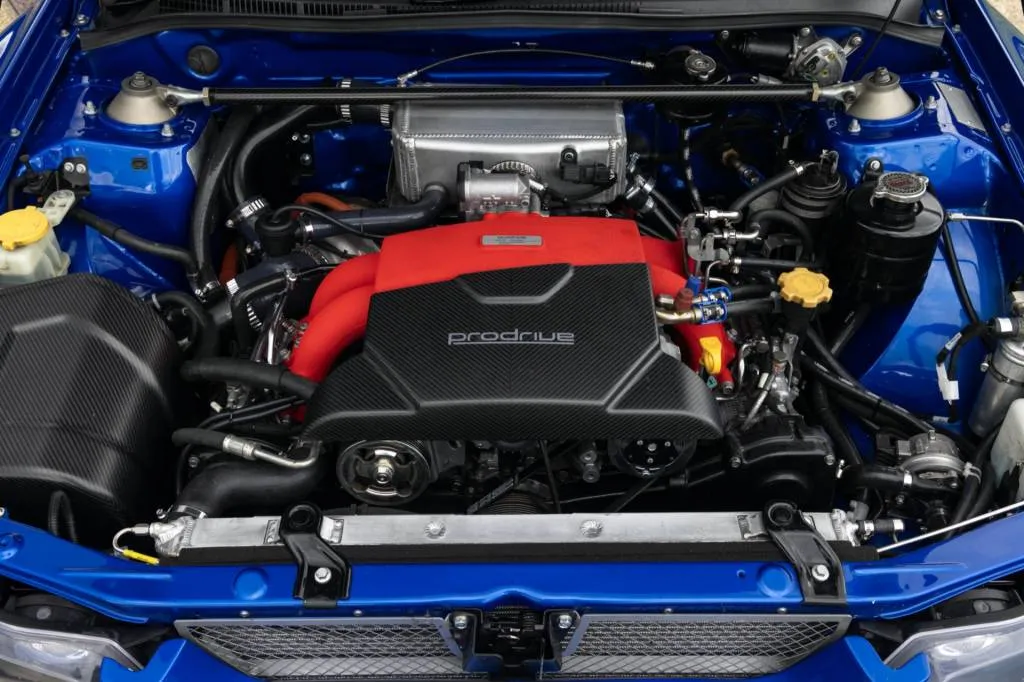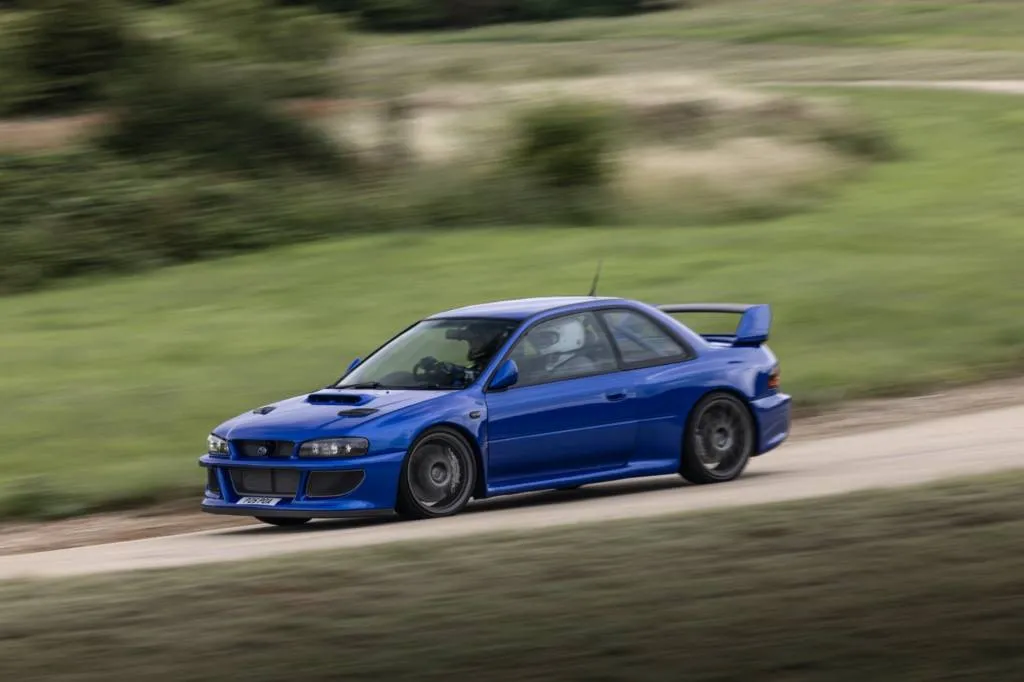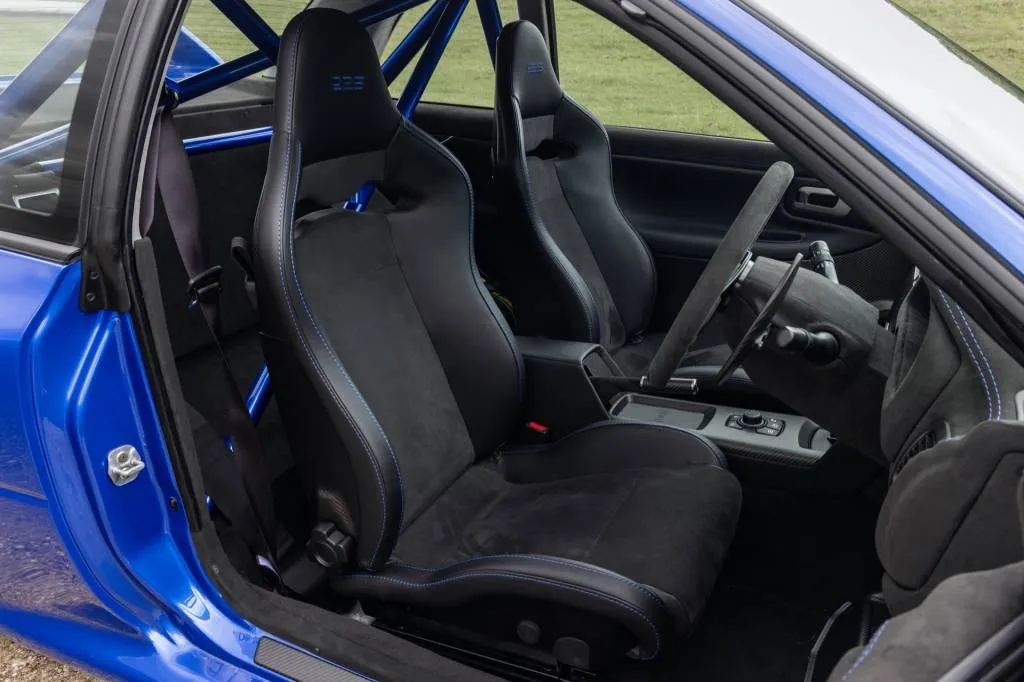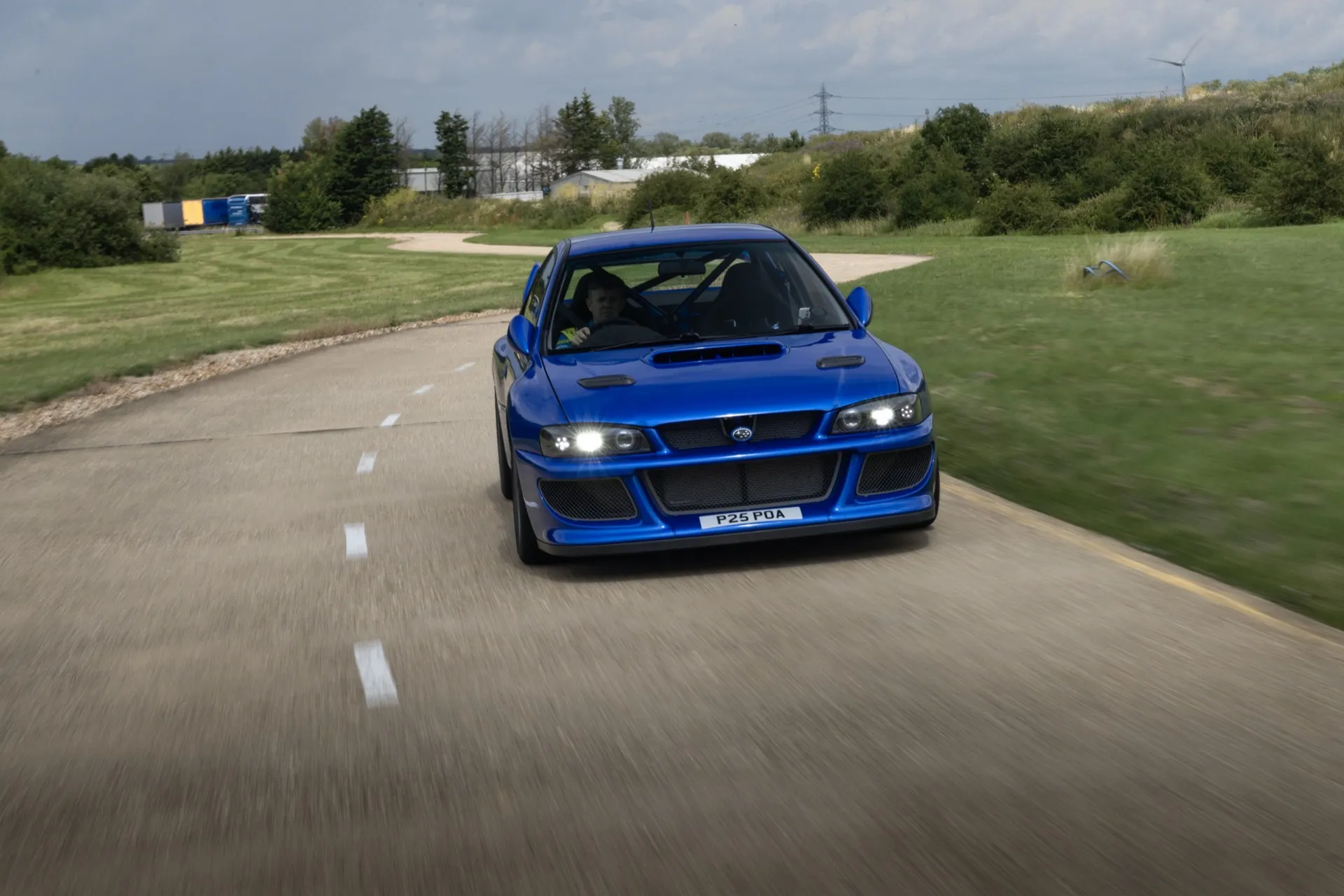Getting into the Prodrive P25 for the first time brought on waves of nostalgia—for what I simultaneously knew well and had never truly experienced.
Like many in a cohort of car-obsessed Gen Xers, I became aware in the 1990s that there was more to motorsports than NASCAR, Formula 1, CART, and the Funny Car and monster truck races happening Sunday, Sunday, Sunday. The one far more interesting to watch—on TV, or in person when I could—was rally racing.
The mid-to-late ‘90s represented a heyday of sorts for Subaru motorsports, as it racked up rally wins with Richard Burns and Colin McRae. Subaru’s performance pedigree today wouldn’t be nearly as exciting without the Impreza 22B STi as a forebear. Made in 1997 to celebrate Subaru’s 40th anniversary, it offered a direct connection from the rally stage to production.
Yet it’s a car that was never sold in Subaru’s largest single market, the U.S.
From a distance, the Prodrive P25 is all but a doppelganger of that icon of the Subaru rally stage, of which just 424 were made globally, most sold in Japan. But for those who want to keep something very special in their garages for track days or back-road blasts, the P25 is even more exclusive. The P25 costs 460,000 British pounds (right around $600,000) as a starting point, not counting tax, delivery charges, non-UK registration fees, import duties, or other bespoke requests. And only 25 or so will be made.
For reference, the most desirable of the original 22Bs now have market prices higher than that. A limited number of those that have been driven have been imported to the U.S., and even the well-used ones are fetching prices beyond $200,000.
Prodrive P25
A Subaru supercar not made by Subaru
So here I was at one of the handling courses at England’s Millbrook Proving Ground, behind the wheel of a car that looks every bit the ‘90s part. But for most intents and purposes, it’s a Subaru supercar underneath.
Those who have clocked some miles in the generation of Impreza Coupe on which this is based—me with the 2.5RS Coupe—the interior is going to simultaneously feel both familiar and different. The carbon fiber throughout, the completely different pedal pads and footwell, the lack of a shift knob and the big paddle alongside the steering wheel all told me that this was something more. So did the well-bolstered sport seats. But the tight floor contour and splayed legs needed to fit comfortably felt just like the accommodations in other Imprezas of the era.
The P25 isn’t a replica, stresses Prodrive. It’s based around the original 1990s-era STi bodyshell but is its own creation—a restomod that at less than 2,700 pounds, is a couple hundred pounds lighter than the original, performs better than it, and doesn’t hold back in tapping into two and a half decades of perspective and motorsports engineering prowess.
Prodrive, it’s worth noting, isn’t part of Subaru. Cars are only part of its motorsport and technology business, although it’s a venue that shows off the company’s fluency with weight-saving composites.

Review: Prodrive P25
P25 packs a Subaru boxer driven to Pro
The engine in the P25 is and isn’t a Subaru creation. It’s a Prodrive-built 2.5-liter turbo-4 based on the Subaru EJ25 engine from recent model years.
Upping the displacement to 2.5 liters helped with torque versus the 2.0-liter Prodrive had been working with, Tomasz Jermolaj, the P25’s engine development engineer, explained to Motor Authority. It then created its own bespoke connecting rods and pistons, and while it used the existing valvetrain as a starting point it created its own valves, springs, and camshaft.
Prodrive has kept developing and refining the P25 since its introduction last year at the 2022 Goodwood Festival of Speed, and with launch control it can now deliver a 0-60 mph time of less than three seconds; last year Prodrive estimated a 0-62 mph time of less than 3.5 seconds.
Prodrive took a tricky approach to helping make sure the P25 always feels on top of its boost. Part of it is sending an extra spoonful of sugar—that’s high-octane gasoline—to the Garrett turbo to keep it spinning on lift, but there’s more to it: simply using more throttle than the engine will ever need.
“Because we keep a boost reserve pre-throttle, and the turbocharger is probably double the speed it should be, so when you add throttle you have that instant torque,” Jermolaj said, adding that using a throttle that’s still at probably 50% of its capacity on a full load helps, too—even though it’s not the most fuel-efficient way to do things.

Prodrive P25
Prodrive P25 is geared for the power plateau
Power is reduced and accelerator inputs softened in the Road mode I first tried. Driving the P25 flat-out—something I didn’t do—would take intense focus, and timing your shifts is a big part of that even though you don’t need to worry about the left pedal (it’s all automated for all but launch). But I got enough of a sample in Sport mode to tell that P25 feels more at home with itself when driven hard. Then, it produces 440 hp from 5,500 rpm all the way to its 7,000-rpm redline, and Prodrive recommends you upshift at 6,500 rpm to extract the most from this “power plateau” with its gearing, which will then drop you back to 5,500 rpm. Meanwhile the torque plateau (official number still TBA) is from 3,000 rpm to 5,500 rpm, so even if you shift well before you should out on the course, the boost always feels like it’s coming on strong and it’s hard to catch the engine flat-footed.
Behind the engine is Prodrive’s motorsport ECU management system—the same one that it puts in its Dakar off-road rally racer. Sport Plus mode alters the center diff behavior and adds launch control. There’s also a WRC-style handbrake that bypasses the center differential, which was essentially transplanted directly from rally racing.

Review: Prodrive P25
The P25 gets limited-slip front and rear differentials and an electronically controlled active center differential. The most important lesson about how to drive the P25 involved the 6-speed sequential-shift gearbox, which is quite an evolution from the 5-speed manual on the 22B. Launching from a standing start and coming back to a stop are the only times when you need to worry about the clutch pedal due to the long paddle mounted to the steering column. Pull the big paddle closer and you upshift; push it forward and you downshift; hold it forward from first and you get to neutral.
If there’s another lesson, it’s that you need to keep your foot in it. In the brief straightaway of the course and in one other point through a corner and exit, I feel the center diff doing its job, and I gain more confidence in the huge six-piston front and four-piston rear AP Racing brakes (there’s no power assist). The nervous, verging on twitchy, steering feel warrants the same initial learning curve. There’s a lot of whine and driveline lash when going gently, and I learn not to lift too quickly, but all those other sounds seemingly disappear when you step into it. I dip into full throttle briefly and find it intoxicating—including the sound from the Akrapovic exhaust and its active bypass that’s loud but not overbearing. Another three laps and I’d be pushing my own capabilities but not the car’s.

Prodrive P25
And then Higgins shows us how
I get that some minutes later, as I hop into the passenger seat with pro rally driver Mark Higgins. He makes the car dance just the right amount for what must be a heck of a lap time. We’re pulling a lot of lateral Gs as we slingshot around that same corner with grace and he finds a way to slightly pivot each way and without too much drama for a quick left-right ess curve along the track. The move makes it feel like an invisible hand momentarily gave us a nudge, and it’s a testament to both the driver, of course, and the toolset this car provides.
Higgins pushes the car far harder through those laps, of course, and I start to smell the clutch, the brakes, the signs of a car given a true workout.
I ask Jermolaj about how many laps the P25 is designed to be driven by a pilot like Higgins, and he replied that the test P25 has more than 20,000 miles with little wear and no failures. It’s engineered to be resilient. The engine and clutch don’t need frequent service or adjustments, and if something blocks the radiator and the temperature spikes, it will dial itself back to road mode and then go back to sport if the temperature recovers.
Prodrive vouches for its engine and says it isn’t built just for track time—and would be up for the task of daily driving, if that’s what the owner intends of a $600,000 car. Further, this is neither a fussy supercar nor an older car, and its layout, with a powertrain box designed by Prodrive and built by Bosch, means there are no fuses and no ancillaries that need their own diagnoses. Owners can simply contact Prodrive and get a quick answer.

Review: Prodrive P25
Bespoke for the road, the track, or both
The P25 is probably the only restomod in the world that is being fully homologated as if it were a regular production model, Prodrive said. It’s running its lights, suspension, and more through British homologation, and it will have a TÜV SÜD approval certificate for Germany and the EU. And yup, some of them will end up in the U.S.
As examples of what it can do on a bespoke basis, customers can choose their own color (P25 blue is the launch color), choose their own wheel color, add a carbon Tarmac splitter, get rid of the back seat, or opt to leave some elements of carbon bodywork exposed, like the mirrors, roof, or the rear wing’s gurney flap.
The P25 is available in left- or right-hand drive, but the tester I had a turn in was right-hand drive. Prodrive has already accommodated some “bespoke” needs, like making the chassis and its Bilstein dampers a little softer for some customers.
The firm had said it would do 25 cars plus three testers, and all 25 production cars are spoken for. But with testing consolidated into one car, it hinted, there may be room for another customer car or two.
What’s apparent after driving the P25, after standing back and soaking it all in, and after talking to some of the people who created it, is that this isn’t a garage queen, and somehow it’s a connector between the current WRX and today’s competition cars. It’s designed to be driven hard and enjoyed—on whatever rally stage that nostalgia points to.
—
Subaru paid for airfare and lodging for Motor Authority to present this firsthand report.

